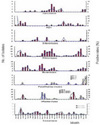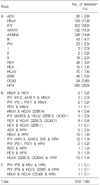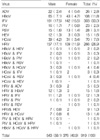Abstract
Background
This investigation was to perform the epidemiological surveillance and genetic analysis on respiratory viral agents from children with acute respiratory infections in Gwangju.
Materials and Methods
For this study, 3,695 specimens obtained from patients with acute respiratory infections were collected by collaboration with pediatric hospitals in Gwangju between 2005 and 2007. Specimens were screened for 8 respiratory viruses including influenza viruses (IFV), human rhinoviruses (HRV), human coronaviruses (HCoV), adenoviruses (ADV), parainfluenza viruses (PIV), human enteroviruses (HEV), respiratory synthitial viruses (RSV) and human bocaviruses (HBoV). Respiratory viruses were detected using multiplex (RT) PCR with viral specific primers.
Results
Out of 3,695 specimens, the ratio of virus detection was 24.9% (919). Overall, HRV (35.5%) and IFV (34.9%) were the most common viruses found, followed by HBoV (14.8%), HCoV (10.6%), RSV (3.7%), ADV (3.4%), PIV (3.2%) and HEV (3.0%). In addition, multiple infections were detected in 80 patients (8.7%). When the prevalence was analyzed according to season, HBoV, IFV and HCoV showed two epidemic points in late spring and early winter. ADV, HRV, RSV PIV and HEV, however, were all found to have only one epidemic point, with RSV being most common during winter and the others being most prominent during spring.
Conclusions
Through this epidemiological surveillance, the respiratory viruses prevalent in children in Gwangju area were investigated. We strongly recommend the development of nationwide policy for the management of prevalent respiratory virus that includes long term collection of data and samples, vaccine development and prevention education of the misuse of antibiotics.
Figures and Tables
 | Figure 1Age and gender distribution in children with acute viral lower respiratory tract infections. |
References
1. Jung BS, Oh JS, Cho B, Kim HH, Lee JS. A clinical study of respiratory tract infections in hospitalized children. Pediatr Allergy Respir Dis. 1996. 6:60–73.
2. Song TS, Jeong YS, Park HJ, Shin MJ. Statistical Observations for Pediatric Inpatients the Second Report Statistically Analyzed for the Patients Admitted to the Pediatric Department of SRCH. J Korean Pediatr Soc. 1985. 28:1–15.
3. Han BC, Kim HK, Lee BC, Lee KS, Cho SH, Lee DB. Statistical observations for pediatric inpatients. J Korean Pediatr Soc. 1987. 30:385–392.
4. Denny FW, Clyde WA Jr. Acute lower respiratory tract infections in nonhospitalized children. J Pediatr. 1986. 108:635–646.

5. Garbino J, Gerbase MW, Wunderli W, Deffernez C, Thomas Y, Rochat T, Ninet B, Schrenzel J, Yerly S, Perrin L, Soccal PM, Nicod L, Kaiser L. Lower respiratory viral illnesses: improved diagnosis by molecular methods and clinical impact. Am J Respir Crit Care Med. 2004. 170:1197–1203.
6. Selwyn BJ. The epidemiology of acute respiratory tract infection in young children: comparison of findings from several developing countries. Coordinated Data Group of BOSTID Researchers. Rev Infect Dis. 1990. 12:suppl 1. S879–S888.
7. Allander T, Tammi MT, Eriksson M, Bjerkner A, Tiveljung-Lindell A, Andersson B. Cloning of a human parvovirus by molecular screening of respiratory tract samples. Proc Natl Acad Sci USA. 2005. 102:12891–12896.

8. Van den Hoogen BG, de Jong JC, Groen J, Kuiken T, de Groot R, Fouchier RA, Osterhaus AD. A newly discovered human pneumovirus isolated from young children with respiratory tract disease. Nat Med. 2001. 7:719–724.

9. Williams JV, Harris PA, Tollefson SJ, Halburnt-Rush LL, Pingsterhaus JM, Edwards KM, Wright PF, Crowe JE Jr. Human metapneumovirus and lower respiratory tract disease in otherwise healthy infants and children. N Engl J Med. 2004. 350:443–450.

10. Yeom HH, Park JS, Jeong DJ, Kim CJ, Kim YB, Lee DH, Kim KJ, Chun JY, Kang C, Chung YS, Cheong HM. Human metapneumovirus infection in Korean children. Korean J Pediatr. 2006. 49:401–409.

11. Park HY, Lee NY, Lee JS, Jung EH, Lee SJ, Ahn KM, Lee SI. An epidemiological study of acute viral lower respiratory tract infections in hospitalized children from 1996 to 2002 in Seoul, Korea. Pediatr Allergy Respir Dis. 2003. 2003:216–226.
12. Park JS. Viral etiology and epidemiology of acute lower respiratory tract infections in hospitalized children (Choongchung province in May 2001 through April 2004). Pediatr Allergy Respir Dis. 2004. 14:366–376.
13. Coiras MT, Aguilar JC, García ML, Casas I, Pérez-Breña P. Simultaneous detection of fourteen respiratory viruses in clinical specimens by two multiplex reverse transcription nested-PCR assays. J Med Virol. 2004. 72:484–495.

14. Chung YS, Kim MK, Cheong HM, Kim IS, Lee JY, Park MS, Kang C. Development of single-tube multiplex PCR for the diagnosis of respiratory viruses. Rep Natl Ins Health. 2003. 40:71–83.
15. Sloots TP, McErlean P, Speicher DJ, Arden KE, Nissen MD, Mackay IM. Evidence of human coronavirus HKU1 and human bocavirus in Australian children. J Clin Virol. 2006. 35:99–102.

16. Arnold JC, Singh KK, Spector SA, Sawyer MH. Human bocavirus: prevalence and clinical spectrum at a children's hospital. Clin Infect Dis. 2006. 43:283–288.

17. Weissbrich B, Neske F, Schubert J, Tollmann F, Blath K, Blessing K, Kreth HW. Frequent detection of bocavirus DNA in German children with respiratory tract infections. BMC Infect Dis. 2006. 6:109.

18. Chung JY, Han TH, Kim CK, Kim SW. Bocavirus infection in hospitalized children, South Korea. Emerg Infect Dis. 2006. 12:1254–1256.

19. Ma X, Endo R, Ishiguro N, Ebihara T, Ishiko H, Ariga T, Kikuta H. Detection of human bocavirus in Japanese children with lower respiratory tract infections. J Clin Microbiol. 2006. 44:1132–1134.

20. Bastien N, Brandt K, Dust K, Ward D, Li Y. Human Bocavirus infection, Canada. Emerg Infect Dis. 2006. 12:848–850.

21. Kim SH, Huh JH, Bae SY, Kim JS, Yoon SY, Lim CS, Cho Y, Kim YK, Lee KN, Lee CK. Epidemiology of Respiratory Viral Infection in 2004-2006. Korean J Lab Med. 2006. 26:351–357.

22. Kim HK, Ham SC, Nam SY, Koh YJ, Ahn KM, Lee SI. A clinical study of adenoviral respiratory infection in children. J Korean Pediatr Soc. 2000. 43:195–202.
23. Lee SY, Oh JW, Lee HB, Lee HR, Ahn KM, Lee SI. Epidemiology of childhood viral respiratory tract infections in Seoul. Pediatr Allergy Respir Dis. 1999. 9:100–108.
24. Olli R, Olli M, Gorgan A. Douglas KR, Richard JW, Frederick GH, editors. Adenoviruses. Clinical Virology. 1997. 1st ed. New York: Churchill Livingstone;525.
25. Pyo JW, Lee HJ. Adenoviral respiratory tract infections in children. Korean J Infect Dis. 1996. 28:493–501.
26. Chong UC, Kim MR, Kim DH, Lee HR, Park CY, Kim HS, Lee KM. A clinical study on acute lower respiratory tract infections by adenovirus in children. J Korean Pediatr Soc. 1998. 41:1070–1077.
27. Glezen P, Denny FW. Epidemiology of acute lower respiratory disease in children. N Engl J Med. 1973. 288:498–505.

28. Ruutu P, Halonen P, Meurman O, Torres C, Paladin F, Yamaoka K, Tupasi TE. Viral lower respiratory infections in Filipino children. J Infect Dis. 1990. 161:175–179.
29. Cane PA, Matthews DA, Pringle CR. Analysis of respiratory syncytial virus strain variation in successive epidemics in one city. J Clin Microbiol. 1994. 32:1–4.

30. Terletskaia-Ladwig E, Enders G, Schalasta G, Enders M. Defining the timing of respiratory syncytial virus (RSV) outbreaks: an epidemiological study. BMC Infect Dis. 2005. 31:20.

31. Lee HJ, Yun BY, Kim MR, Yun CK. Viral Etiology and Epidemiology of Acute Lower Respiratory Tract Infections in Children. Korean J Infect Dis. 1995. 27:319–332.
32. Han MY, Lee BL, Seo WH, Ahn SH, Kim SJ, Hwang SJ, Park HY, Ahn KM, Lee SI. Epidemiology of respiratory syncytial virus lower respiratory tract infection and analysis of risk factors in severe infections from 1995 to 2004. Pediatr Allergy Respir Dis. 2005. 15:150–159.
33. Lee SJ, Park EY, Oh PS, Lee KH, Kim KN, Lee KM. Viral Ptterns and Clinical Analysis of Acute Respiratory Tract Infections of Children in Korea (September, 1998-August, 2002). Korean J Pediatr Infect Dis. 2003. 10:102–113.

34. Chanock RM, Parrott RH, Johnson KM, Kapikian AZ, Bell JA. Myxoviruses: Parainfluenza. Am Rev Respir Dis. 1963. 88:suppl 1. 152–166.
35. Lemen RJ, Quan SF, Witten ML, Sobonya RE, Ray CG, Grad R. Canine parainfluenza type 2 bronchiolitis increases histamine responsiveness in beagle puppies. Am Rev Respir Dis. 1990. 141:199–207.

36. Lee SJ, Shin EW, Park EY, Oh PS, Kim KN, Yoon HS, Lee KM. Epidemiology and clincal analysis of acute viral respiratory tract infections in children (September, 1998-May, 2003). Korean J Pediatr. 2005. 48:266–275.
37. Wright P. Behrman RE, Kliegman RM, Arvin AM, Jenson HB, editors. Influenza viruses. Nelson textbook of pediatrics. 2004. 17th ed. Philadelpia: WB Saunders Co.;1072.
38. Wiley DC, Skehel JJ. The structure and function of the hemagglutinin membrane glycoprotein of influenza virus. Annu Rev Biochem. 1987. 56:365–394.

39. Kwon MK, Kim MR, Park EY, Lee KH, Yoon HS, Kim KN, Lee KM. Clinical analysis of acute respiratory tract infections by influenza virus in children. J Korean Pediatr Soc. 2002. 45:1519–1527.
40. Kee NY, Ki CS, Kim SJ, Lee YW, Jeong GY, Lee SI, Kim JH. Epidemiological and clinical analysis of influenza and viruses isolation during winter of 1996-1997. Korean J Infect Dis. 1997. 29:263–270.
41. Nah SY, Park SE, Park JY, Lee HJ. Epidemiology of influenza virus over 8 years (1990-1998) in Seoul, Korea. Korean J Infect Dis. 1999. 31:210–216.
42. Hall CB, Douglas RG Jr. Respiratory syncytial virus and influenza. Practical community surveillance. Am J Dis Child. 1976. 136:615–620.
43. Hwang YO, Seo BT, Choi BH. Analysis of isolation and subtyping of influenza virus in Seoul, During 1999-2003. J Bacteriol Virol. 2004. 34:67–74.
44. Wege H, Siddell S, ter Meulen V. The biology and pathogenesis of coronaviruses. Curr Top Microbiol Immunol. 1982. 99:165–200.

45. Isaacs D, Flowers D, Clarke JR, Valman HB, MacNaughton MR. Epidemiology of coronavirus respiratory infections. Arch Dis Child. 1983. 58:500–503.

46. Pitkaranta A, Virolainen A, Jero J, Arruda E, Hayden FG. Detection of rhinovirus, respiratory syncytial virus, and coronavirus infections in acute otitis media by reverse transcriptase polymerase chain reaction. Pediatrics. 1998. 102:291–295.
47. Couch , Robert B. Rhinovirus, Virology. 1990. 2nd ed. New York: Raven Press;607–629.
48. Fox JP, Cooney MK, Hall CE. The Seattle virus watch. V. Epidemiologic observations of rhinovirus infections 19651969, in families with young children. Am J Epidemiol. 1975. 101:122–143.
49. Fox JP, Cooney MK, Hall CE, Foy HM. Rhinoviruses in Seattle families, 1975-1979. Am J Epidemiol. 1985. 122:830–846.

50. Monto AS, Cavallaro JJ. The Tecumseh study of respiratory illness. IV. Prevalence of rhinovirus serotypes, 1966-1969. Am J Epidemiol. 1972. 96:352–360.

51. Jee Y, Cheon D, Choi W, Ahn J, Kim K, Chung Y, Lee J, Lee K, Noh H, Park K, Lee S, Kim S, Cho K, Kim E, Jung J, Yoon J, Cho H. Updates on enterovirus surveillance in Korea. Infect Chemother. 2004. 36:294–303.
52. Kogon A, Spigland I, Frothingham TE, Elveback L, Williams C, Hall CE, Fox JP. The virus watch program: A continuing surveillance of viral infections in metropolitan New York families. VII. Observations on viral excretion, seroimmunity, intrafamilial spread and illness association in coxsackie and echovirus infections. Am J Epidemiol. 1969. 89:51–61.

53. Gondo K, Kusuhara K, Take H, Ueda K. Echovirus type 9 epidemic in Kagoshima, southern Japan: seroepidemiology and clinical observation of aseptic meningitis. Pediatr Infect Dis J. 1995. 14:787–791.
54. Moore M, Kaplan MH, McPhee J, Bregman DJ, Klein SW. Epidemiologic, clinical, and laboratory features of Coxsackie B1B5 infections in the United States, 197079. Public Health Rep. 1984. 99:515–522.
55. Hietala J, Uhari M, Tuokko H, Leinonen M. Mixed bacterial and viral infections are common in children. Pediatr Infect Dis J. 1989. 8:683–686.





 PDF
PDF ePub
ePub Citation
Citation Print
Print








 XML Download
XML Download